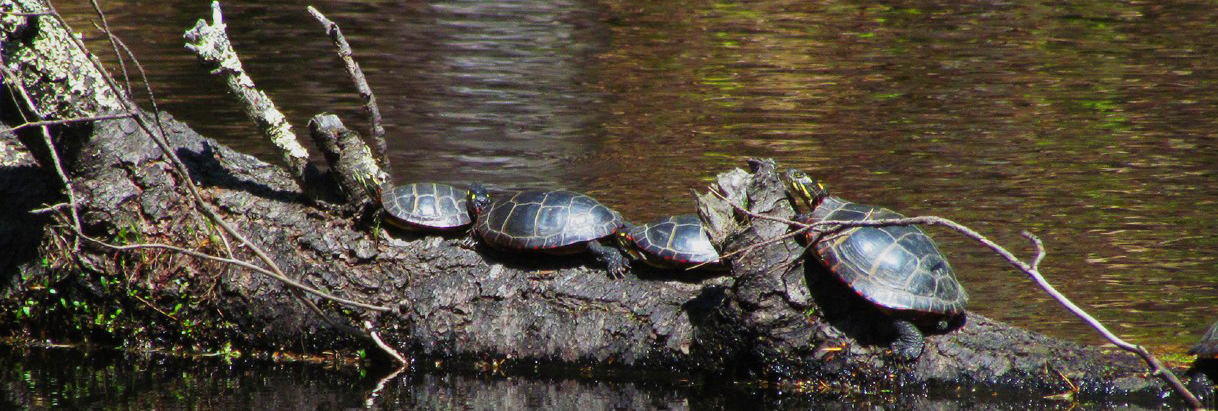The Nature of a Long Winter’s Nap
by Suzanne Petersen, education specialist, Lamprey River Advisory Committee
The Cold Facts of Winter
Winter is a difficult time of year for most living things. Tissues of the body must not freeze. Drinking water and food might be scarce. What are animals to do? Some animals migrate to a warmer climate, ex. monarch butterflies and great blue herons. Some animals stay here and remain active, ex. chickadees and foxes. Some animals become less active and live on stored food or what little they can find, ex. squirrels and deer. Some animals settle in for a long winter’s nap; they hibernate.
True hibernation means that an animal enters a state of reduced bodily functioning. The heart beat slows to a fraction of its normal rate. Breathing slows and can become shallow or undetectable. Body temperature can drop to near freezing, even in mammals. Little or no food and water are consumed. Due to this low level of functioning, hibernating animals are slow to respond to external stimuli such as intruders or pain. They can, however, have periods of wakefulness.
Getting Ready
To prepare for hibernation, most animals eat to gain weight and build fat. Fat provides a layer of insulation. It also releases heat and water when it is broken down. Animals also need to find a suitable place to hibernate. Once they find such a site, they settle in and their bodily processes slow down. It is this slowing that causes hibernating animals’ body temperature to drop, not the temperature outside.
Hibernation or Something Else?
Many people believe that black bears hibernate. These animals do not enter a state of true hibernation, but scientists have not agreed exactly what it is. As winter approaches, the bears find a suitable den and settle in for the winter. They become sleepy and their heart rate and breathing become slower, but their body temperature does not drop significantly. If disturbed, over-wintering black bears can quickly become alert and active.
Bats enter a deep sleep called “torpor” that is very similar to true hibernation. Their bodily functions slow and their body temperature drops, but they can react quickly if disturbed. Sadly, some bat species, including some in New Hampshire, are facing a troubling future. Their normal hibernation cycle is being disturbed by “white nose syndrome”. Scientists are unsure of what causes the disorder or how to treat it, and it is fatal. Afflicted bats either do not have enough stored fuel or they burn it too quickly to see them through winter. They are then forced to become active to find food before it is available, making them even weaker. One way people can help is to stay away from known bat hibernation caves during winter so that the bats are not disturbed.
The only New Hampshire mammals that enter a state of true hibernation are woodchucks (or groundhogs) and two species of jumping mice. Jumping mice hibernate for two to three weeks, awaken briefly, and then return to hibernation. Woodchucks go into hibernation in late September and begin to awaken in February. They then remain active until the next winter. Other mammals such as skunks, raccoons, and chipmunks enter torpor, but they can awaken quickly to take advantage of opportunities to look for food on mild winter days. Birds do not seem to hibernate. Only one species, the common poorwill of the southwestern US, enters torpor for periods of time.
Can "Cold Blooded" Animals Get Too Cold?
Reptiles, being “cold blooded”, are not able to create their own heat. Their bodies easily tolerate cold as long as they do not get so cold that they freeze. Snakes often burrow in the ground below the frost line or find a compost pile that generates a bit of warmth. Turtles overwinter by burying themselves in sediment at the bottom of a pond or at the base of a river bank. The pond or river can ice over, but liquid water usually remains below the surface. The turtles do not breathe at this time. Some, such as wood turtles, absorb a bit of oxygen through patches of thin skin, but others, such as spotted turtles, simply “hold their breath”. Many amphibians in New Hampshire hibernate in or on the sediments of ponds or wetlands. Some hibernate on land in burrows that lie below the frost line.
Three of New Hampshire’s frogs, the wood frog, the gray tree frog, and the spring peeper, actually do freeze during the winter. These frogs have chemical adaptations in the fluids of their bodies that serve as an antifreeze and prevent the formation of ice crystals. Painted turtle hatchlings also have this adaptation to a lesser degree. They hatch from their eggs in the fall, but remain in their dry, sandy nests until spring. The hatchlings are able to withstand some freezing, but unlike the frogs, the baby turtles cannot survive freezing solid. The baby turtles are most vulnerable during a cold winter without a good layer of snow.
When Spring Returns
Hibernation is an interesting way that many animals survive winter by yielding to it. When spring arrives, nature will welcome the return of animals that went south as well as those animals that were here all the time and just needed to wake up from a long winter’s nap.

